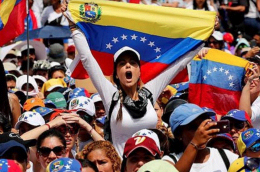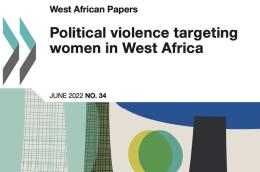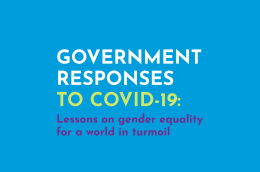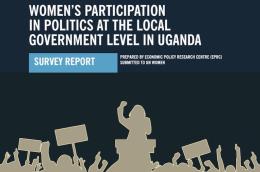Women's Leadership
Main navigation
Despite some small advances and changes in legislation, both chavismo and the opposition make things more difficult for female politicians. But Venezuela could take some steps towards equality.
The level of women’s participation in Venezuelan politics is discouraging. Although the recent political conflict, electoral distrust, the prolonged economic, humanitarian and migration crises limit women’s participation in politics, they don’t tell the whole story on women’s exclusion from Venezuelan politics.
In reality, internal political structures and leadership roles remain dominated by men, especially within Venezuela’s most relevant political parties and institutions. Of the fifteen permanent commissions in the 2015 National Assembly—the only de jure legislature in Venezuela led by the caretaker government presided by Juan Guaidó—only two are led by women. Women are excluded from decision-making in high-profile policy areas like energy and the economy.
Click here to read the full article published by Caracas Chronicle on 16 June 2022.
Women around the world are facing unprecedented levels of targeted political violence. This is also true in West Africa. Women can be targeted in a myriad of ways, by an array of types of perpetrators, during and outside of periods of conflict and contentious crises. The result though is consistent: such targeted violence has worrying implications for women’s political participation as well as their involvement in the public sphere. Political violence targeting women (PVTW) in West Africa has become increasingly common, with this trend increasing even more dramatically in recent years. The threat and risks, however, have not been uniform: different types of violence and different primary perpetrators dominate the gendered violence landscape across countries. Using data from ACLED, this paper tracks how women are targeted, and who is targeting women. Only by understanding how threats and risks that women face differ across countries can strategies be created to protect women.
Click here to access the report.
This new report presents a clarion opportunity to champion improved, gender-responsive social protections and to ensure meaningful participation of women to identify solutions to acute and chronic challenges that leave no one behind.
NEW YORK - Countries with greater women’s leadership, universal social protection and care systems, and space for feminist organizations to participate in democratic decision-making are more effective at responding to crises such as the COVID-19 pandemic, according to a new global report released today by UN Women and the United Nations Development Programme (UNDP).
As the overlapping impacts of the COVID-19 pandemic, a deepening climate emergency and geopolitical conflicts threaten gender equality and women’s rights, analysis based on new global data provides specific recommendations for governments to ensure their economic recovery and emergency preparedness strategies are gender responsive, integrated and resilient.
Click here to read the full article published by UNDP on 23 June 2022.
The overlapping impacts of the COVID-19 pandemic, accelerating climate disasters, and geopolitical conflict are a threat to gender equality and women’s rights across the globe. This report from UN Women and UNDP shows what governments can do now to prevent further rollbacks and recover lost ground, while enhancing resilience and preparedness for future shocks.
Drawing on a unique global dataset of close to 5,000 measures adopted by 226 countries and territories in response to COVID-19, the report finds that, overall, government responses paid insufficient attention to gender dynamics. At the same time, instances of innovation and learning hold important lessons for gender-responsive policymaking in times of crisis.
For the first time, the report provides analysis on the factors that led to a strong gender response, generating key lessons for governments:
- In a context of growing threats to democratic and open societies, strong institutions proved critical for an inclusive gender response.
- Feminist movements and women’s rights organizations provided an early warning system on the gender impacts of the pandemic, particularly on violence against women and girls.
- Women’s representation and leadership in executive positions, parliaments, and public administration was critical for translating feminist advocacy into policy action.
- Countries with robust public services and gender-responsive social protection systems were in a better position to respond, while others had to improvise, under pressure, and with varying degrees of success.
- Digital tools sustained feminist activism online and enabled policy innovations and rapid support roll-out, reaching groups of women often left behind in “normal times”.
- Real-time gender data on the impact of the pandemic on women and girls was critical to making the case for gender-sensitive response measures, as was tracking what worked in government responses.
Click here to download the report.
WARNING: PROFANE LANGUAGE
The fabricated sex videos posted online purportedly of Aika Robredo and Tricia Robredo, daughters of Vice President Leni Robredo, are among the recent cases of disinformation circulating in cyberspace that are framed in the vitriol of misogyny. The attack on the young Robredos is obviously an attempt to damage their mother’s bid for the presidency. Many are shocked but not surprised, given the increasingly heated campaign in which the only female candidate is perceived to pose a formidable threat to the nine other presidential aspirants, all male. That the disturbing fakery was not exactly unexpected indicates the alarming yet taken-for-granted consequence of any form of political engagement by women – both in the real world and in virtual space.
This analysis is premised on the observation that misogyny – the intense prejudice against and contempt for women – has become more ferocious in cyberspace in recent years, particularly against those critical of President Rodrigo Duterte, and now during the lead-up to the 2022 elections. This report analyzes a relatively small but significant sample of the appalling number of misogynistic memes, posts, and comments that fan the flame of misogyny, with an equally sickening number of likes and shares from like-minded users, from 2015 to 2020. The following will be discussed as I work through the argument that cybermisogyny violates human rights. It is a disruption of peace, an affront to dignity and equality, and a threat to safety and security. It jeopardizes women’s right to work. As it tends to silence women, cybermisogyny undermines democracy.
Click here to read the full article published by The Daily Guardian on 22 May 2022.
Uganda adopted the Sustainable Development Goals (SDGs) and was one of the first countries to integrate them into its National Development Plan. Under Goal 5, countries commit to promoting and guaranteeing women’s full and effective participation and equal opportunities for leadership at all levels of decision-making. This survey report is a follow-up of the baseline survey of women in local governments that was conducted by the Uganda Bureau of Statistics in 2017 and addresses three specific objectives:
1) To update and track progress towards attainment of gender parity in political representation at LG level;
2) To assess the extent to which women in LGs effectively contribute to local decision-making processes; and
3) To provide a deeper understanding of the factors that hinder elected women in LGs from effectively fulfilling their mandate.
The study was undertaken using Local Government (LG)’s election data from the Electoral Commission and survey data collected through key informant interviews with political leaders at the LG levels and focus group discussions with community people. The survey was conducted in Gulu, Nwoya, and Pader in the North; Napak, and Morotoin Karamoja sub-region; Pallisa and Bugiri in the East; and Kiryandongo in the West. Survey data was analysed using both quantitative (descriptive statistics) and qualitative techniques, which involved qualitative data from focus group discussions and open-ended survey responses from individual respondents was analysed through the following steps: transcribing the qualitative responses; pooling the transcribed responses from the various FGDs according to specific research questions; identifying the main ideas that occur in the answers to each question and creating themes; and writing narratives to describe the themes.
Click here to download the report.





